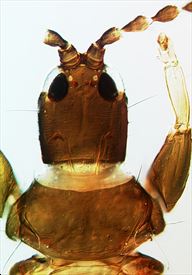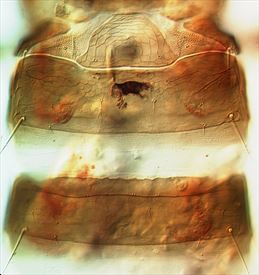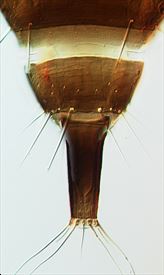Distinguishing features
Both sexes fully winged or micropterous. Brown, but extreme base of antennal segment III, tarsi, distal half of fore tibiae, and apex of middle and hind tibiae yellow; fore wings shaded, pale at apex; major setae pale brown. Head faintly sculptured, with up to 3 stout cheek setae on lateral margins; compound eyes larger dorsally than ventrally; ocellar area slightly raised; postocular setae wide apart, blunt to capitate. Antennae 8-egmented; segment VIII without a distinct pedicel, closely joined to VII; III and IV each with 3 sense cones. Pronotum with anteroangular and epimeral setae capitate, midlateral setae blunt to capitate, posteroangular setae acute; anteromarginal setae almost as short as discal setae. Metanotum with median pair of setae acute, wide apart, almost on raised submarginal area; metathoracic sternopleural sutures short. Fore wings with 10–11 duplicated cilia. Pelta reticulate, with small lateral lobes; tergites II–VIII each with 2 pairs of wing-retaining setae, curved on II, sigmoid on III–VII; tergite IX posteromarginal setae S1 bluntly expanded. Female microptera with antennal sense cones shorter; ocelli smaller; tergal wing-retaining setae small, curved, not sigmoid.
Male with postocular setae and major pronotal setae with spatulate apices; fore tarsal tooth larger; fore femora swollen; pronotum with median longitudinal apodeme; tergite IX posteromarginal setae S2 short, stout, acute; sternites III–VII with paired areas of specialised reticulation laterally; sternite VIII with a thin, transverse pore plate.
Related species
There are 23 species listed in the genus Deplorothrips, of which 14 are known only from Australia, one only from New Zealand, and the others from southeast Asia. However, D. bassus is currently interpreted as a remarkably variable species, and in view of recent studies on the Australian fauna (Mound & Tree, 2016), this interpretation needs further study. The considerable variation within and between the samples excluded from the type series of D. bassus was summarised in Table 1, page 50 of Mound & Walker (1986).
Biological data
Presumably feeding on fungal hyphae or their break-down products, this species has been taken from dead branches in native habitats particularly in association with a Stereum-like white fungus.
Distribution data
Known only from New Zealand (ND, AK, CL, WO, BP, TO, TK / SD, NN, BR, WD, MC, MK, OL, DN).
Family name
PHLAEOTHRIPIDAE, PHLAEOTHRIPINAE
Species name
Deplorothrips bassus Mound & Walker
Original name and synonyms
Deplorothrips bassus Mound & Walker, 1986: 49
References
Mound LA & Tree DJ (2016) Australian mycophagous species of the genus Deplorothrips (Thysanoptera, Phlaeothripinae). Zootaxa 4208 (3): 201–220.
Mound LA & Walker AK (1986) Tubulifera (Insecta: Thysanoptera). Fauna of New Zealand 10: 1–140.



